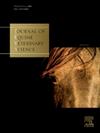Insulinemic responses to long-stem forage hay in horses with insulin dysregulation (ID)
IF 1.3
3区 农林科学
Q2 VETERINARY SCIENCES
引用次数: 0
Abstract
Maintaining healthy postprandial responses in insulin dysregulation (ID) horses is key to preventing hyperinsulinemia-associated laminitis. This study investigated meal feeding preserved forage (hay) with different nonstructural carbohydrate (NSC) content on the insulin responses in ID versus non-insulin dysregulated (NID) horses basally fed low-NSC hay plus a balancer. Ten horses were categorized as ID (n = 5; 593 ± 95.3kgs) or NID (n = 5; 607.6 ± 68.4 kg). The randomized 5-wk crossover study comprised 2 treatments per week. Six diets were fed once per horse: a positive control (oat groats [OG]; 546 g NSC/kg as-fed); a negative control (low-NSC pellet [LNSC]; 75 g NSC/kg as-fed); and 4 forages: orchardgrass hay (OH; 64 g NSC/kg as-fed); alfalfa hay (AH; 67 g NSC/kg as-fed); timothy hay 1 (TH1; 90 g NSC/kg as-fed); and timothy hay 2 (TH2; 163 g/kg as-fed). Control and forage diets were fed at 1.0 g and 2.0 g/kg BW per meal, respectively, after an overnight fast on a drylot with ad libitum water. This resulted in meal NSC intakes (g/kg BW) of 0.07 for LNSC, 0.13 for OH, 0.135 for AH, 0.18 for TH1, 0.33 for TH2, and for 0.55 OG. Blood samples were collected before feeding and after consumption of the meal at 0 (meal completion), 60, 90, 120, 180, and 240 min. Blood samples were analyzed for insulin by automated immunoassay analyzer (Tosoh). A 2-way ANOVA was performed using GraphPad Prism. Data were log-transformed to achieve normality. Statistical significance was considered at P < 0.05, and data are presented as the mean ± SEM. All meals were consumed in 10 ± 1 min for controls and 45 ± 2 min for forages. Peak and delta insulin for ID horses were greater (P < 0.05) for all dietary treatments compared with NID. The ID and NID horses’ peak insulin were higher for OG (ID: 725.3 ± 169.6 μIU/mL; NID: 31.2 ± 7.9 μIU/mL) compared with all other feedstuffs (P < 0.01). In addition, TH1 and TH2 peak insulin for ID horses was higher than LNSC (109.0 ± 18.2; 134.0 ± 34.7; 45.9 ± 5.0 μIU/mL respectively, P < 0.01). Delta insulin was also higher for OG than all other feedstuffs for both ID (693.2 ± 170.6 μIU/mL) and NID (25.5 ± 7.1 μIU/mL; P < 0.01). For the NID delta insulin was also higher for TH2 (7.1 ± 2.3 μIU/mL) than OH (3.6 ± 3.0 μIU/mL; P < 0.01). For the ID horses the delta insulin for the LNSC (14.8 ± 3.6 μIU/mL) was significantly lower than AH (45.0 ± 6.9 μIU/mL), TH1 (80.5 ± 17.0 μIU/mL), and TH2 (99.7 ± 29.9 μIU/mL), but not OH (38.3 ± 8.1 μIU/mL). Insulin responses to hay were individually variable. Despite AH and TH1 having NSCs of ≤9% on an as-fed basis (∼10% DM) there was an augmented insulin response compared with the LNSC. Results suggest that feeding a forage >0.13 g NSC/kg BW per meal may produce an augmented insulin response in ID horses. Further work is needed to investigate feeding larger amounts of long-stem forages on insulin responses.
胰岛素失调(ID)马对长茎牧草的胰岛素反应
在胰岛素失调(ID)马保持健康的餐后反应是预防高胰岛素相关性板炎的关键。本研究研究了饲喂不同非结构性碳水化合物(NSC)含量的保存草料(干草)对ID马和饲喂低NSC草料加平衡器的非胰岛素失调(NID)马胰岛素反应的影响。10匹马被分类为ID (n = 5;593±95.3kg)或NID (n = 5;607.6±68.4 kg)。这项为期5周的随机交叉研究包括每周2次治疗。每匹马饲喂一次6种饲料:阳性对照(燕麦杂粮[OG];546 g NSC/kg饲料);阴性对照(低nsc颗粒[LNSC];75 g NSC/kg饲料);4种牧草:果园草干草(OH;64 g NSC/kg饲料);苜蓿干草;67 g NSC/kg饲料);timothy hay 1 (TH1;90 g NSC/kg饲料);和提摩太干草2 (TH2;163 g/kg饲料)。对照饲粮和草料饲粮分别饲喂1.0 g/kg BW和2.0 g/kg BW,在旱地上禁食一夜,随意取水。结果表明,低NSC的饲粮NSC摄入量(g/kg BW)为0.07,OH为0.13,AH为0.135,TH1为0.18,TH2为0.33,OG为0.55。分别于进食前、进食后0、60、90、120、180和240 min采集血样。采用自动免疫分析仪(Tosoh)对血样进行胰岛素分析。采用GraphPad Prism进行双因素方差分析。对数据进行对数变换以达到正态性。P <考虑统计学显著性;0.05,数据以平均值±SEM表示。对照组在10±1 min内进食,饲料组在45±2 min内进食。ID马的胰岛素峰值和δ值更高(P <;0.05)。ig组和NID组的胰岛素峰值均高于ig组(ID: 725.3±169.6 μIU/mL;NID: 31.2±7.9 μIU/mL),与其他饲料(P <;0.01)。此外,ID组马的TH1和TH2胰岛素峰值高于LNSC组(109.0±18.2;134.0±34.7;P和lt分别为45.9±5.0 μIU/mL;0.01)。δ胰岛素对OG的ID(693.2±170.6 μIU/mL)和NID(25.5±7.1 μIU/mL)均高于其他饲料;P & lt;0.01)。对于NID患者,胰岛素对TH2的作用(7.1±2.3 μIU/mL)高于OH(3.6±3.0 μIU/mL);P & lt;0.01)。对于ID马,LNSC组δ胰岛素(14.8±3.6 μIU/mL)显著低于AH组(45.0±6.9 μIU/mL)、TH1组(80.5±17.0 μIU/mL)和TH2组(99.7±29.9 μIU/mL),而OH组(38.3±8.1 μIU/mL)差异不显著。胰岛素对干草的反应是个体可变的。尽管AH和TH1在喂养基础上具有≤9%的NSCs (~ 10% DM),但与LNSC相比,胰岛素反应增强。结果表明,每顿饲粮添加0.13 g NSC/kg BW的饲料可能会增强ID马的胰岛素反应。需要进一步研究喂食大量长茎牧草对胰岛素反应的影响。
本文章由计算机程序翻译,如有差异,请以英文原文为准。
求助全文
约1分钟内获得全文
求助全文
来源期刊

Journal of Equine Veterinary Science
农林科学-兽医学
CiteScore
2.70
自引率
7.70%
发文量
249
审稿时长
77 days
期刊介绍:
Journal of Equine Veterinary Science (JEVS) is an international publication designed for the practicing equine veterinarian, equine researcher, and other equine health care specialist. Published monthly, each issue of JEVS includes original research, reviews, case reports, short communications, and clinical techniques from leaders in the equine veterinary field, covering such topics as laminitis, reproduction, infectious disease, parasitology, behavior, podology, internal medicine, surgery and nutrition.
 求助内容:
求助内容: 应助结果提醒方式:
应助结果提醒方式:


